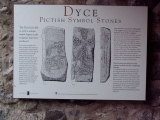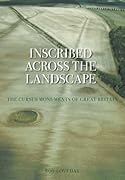<< Our Photo Pages >> Dyce Pictish Stones - Class I / Class II Hybrid Pictish Symbol Stone in Scotland in Aberdeenshire
Submitted by cosmic on Wednesday, 20 October 2004 Page Views: 11608
Early Medieval (Dark Age)Site Name: Dyce Pictish StonesCountry: Scotland
NOTE: This site is 0.899 km away from the location you searched for.
County: Aberdeenshire Type: Class I / Class II Hybrid Pictish Symbol Stone
Nearest Town: Aberdeen Nearest Village: Dyce
Map Ref: NJ875154
Latitude: 57.229157N Longitude: 2.208677W
Condition:
| 5 | Perfect |
| 4 | Almost Perfect |
| 3 | Reasonable but with some damage |
| 2 | Ruined but still recognisable as an ancient site |
| 1 | Pretty much destroyed, possibly visible as crop marks |
| 0 | No data. |
| -1 | Completely destroyed |
| 5 | Superb |
| 4 | Good |
| 3 | Ordinary |
| 2 | Not Good |
| 1 | Awful |
| 0 | No data. |
| 5 | Can be driven to, probably with disabled access |
| 4 | Short walk on a footpath |
| 3 | Requiring a bit more of a walk |
| 2 | A long walk |
| 1 | In the middle of nowhere, a nightmare to find |
| 0 | No data. |
| 5 | co-ordinates taken by GPS or official recorded co-ordinates |
| 4 | co-ordinates scaled from a detailed map |
| 3 | co-ordinates scaled from a bad map |
| 2 | co-ordinates of the nearest village |
| 1 | co-ordinates of the nearest town |
| 0 | no data |
Internal Links:
External Links:
I have visited· I would like to visit
pawel visited on 29th Nov 2019 - their rating: Cond: 3 Amb: 4 Access: 5 Access - you can drive right up to the cemetery. The entry gate is small so people in a wheelchair won't pass through. There are six stones, two large slabs and 4 smaller ones, all next to each other attached to a inner wall of a ruined 13th-century church dedicated to a Pictish missionary, St. Fergus. The chapel is on a premises of a old cemetery.
There is an information board from Historic Scotland giving as a brief history of the stones.
The stones have been in this shelter since 1880s.
The symbols are of Pictish origins and are dated to be some 1100 years old. The symbols include mythical beasts and crosses. There is also written inscription on the side of cross slab in a scripts called ogham.
SandyG visited on 21st Sep 2014 - their rating: Cond: 3 Amb: 3 Access: 5
HaggisAction have visited here
Average ratings for this site from all visit loggers: Condition: 3 Ambience: 3.5 Access: 5

There are two symbol stones (NJ81NE 8.01 and 8.02) in a recess in the E gable of St Fergus' Church (NJ81NE 13). One (NJ81NE 8.01) is of Class I and is incised with an 'elephant' symbol above a double disc and Z-rod. The other (NJ81NE 8.02) is of Class II and is sculpted on one face only with a Celtic cross ornamented with a central boss of spiral work and elsewhere with interlace. Beside it and below the shaft are the crescent and V-rod, mirror case, double disc and Z-rod, and the triple ring symbols.
Both of these stones are said to have been found in the glebe. They were built into the churchyard wall for a long time before being placed in their present position (J R Allen and J Anderson 1903).
J Ritchie 1911; E W MacKie 1975; R W Feachem 1963
Four other stones (NJ81NE 8.03), which have been turned up in the graveyard, are also preserved in the recess. They vary in size from 12ins by 6ins by 2ins up to 2ft 11ins by 1ft 10ins by 11/2ins; each bears a carved cross of different design (illustrated by Ritchie).
Visited by OS (EGC) 20 October 1961.
J Ritchie 1911.
You may be viewing yesterday's version of this page. To see the most up to date information please register for a free account.










Do not use the above information on other web sites or publications without permission of the contributor.
Click here to see more info for this site
Nearby sites
Key: Red: member's photo, Blue: 3rd party photo, Yellow: other image, Green: no photo - please go there and take one, Grey: site destroyed
Download sites to:
KML (Google Earth)
GPX (GPS waypoints)
CSV (Garmin/Navman)
CSV (Excel)
To unlock full downloads you need to sign up as a Contributory Member. Otherwise downloads are limited to 50 sites.
Turn off the page maps and other distractions
Nearby sites listing. In the following links * = Image available
282m NW 315° St Medden's Kirkyard* Class I Pictish Symbol Stone (NJ873156)
2.7km SW 215° Tyrebagger* Stone Circle (NJ85951322)
2.9km N 353° Monykebbuck* Standing Stone (Menhir) (NJ8715418291)
3.5km WSW 253° The Slacks* Cairn (NJ841144)
3.6km W 281° Donald's Hillock* Cairn (NJ84001609)
3.6km S 180° Dyce Stones* Standing Stones (NJ87481175)
4.0km WNW 283° Fintray Cursus Cursus (NJ83571633)
4.0km W 267° Gouk Stone* Standing Stone (Menhir) (NJ8344815171)
4.1km WNW 283° Mill of Fintray Cursus Multiple Stone Rows / Avenue (NJ835163)
4.3km SSW 193° Holy Well (Chapel of Stonyewood)* Holy Well or Sacred Spring (NJ865112)
5.4km W 259° Kinellar Churchyard* Stone Circle (NJ82161440)
5.5km W 259° Kinellar Pictish Symbol Stone* Class I Pictish Symbol Stone (NJ821144)
5.5km SE 128° Whitestripes Henge (NJ919120)
6.0km WSW 255° Cairntradlin* Standing Stone (Menhir) (NJ81681385)
6.1km NNW 344° St Mary's Well (Straloch)* Holy Well or Sacred Spring (NJ858213)
6.5km WSW 247° Newton of Lewesk* Class I Pictish Symbol Stone (NJ815129)
6.5km NW 304° Peathill* Standing Stone (Menhir) (NJ8210419068)
6.7km WNW 291° Greenlands* Ancient Village or Settlement (NJ81231778)
6.9km ESE 109° Mundurno* Stone Circle (NJ940131)
6.9km ESE 109° Dubford Standing Stone (Menhir) (NJ9400313096)
7.0km SW 228° Tertowie* Standing Stone (Menhir) (NJ823107)
7.3km W 263° Ferneybrae* Standing Stone (Menhir) (NJ80211459)
7.8km E 83° Potterton* Stone Circle (NJ9529716365)
8.0km W 270° Tuack* Stone Circle (NJ795154)
8.0km W 268° Midmill Chambered Cairn (NJ795151)
View more nearby sites and additional images






 We would like to know more about this location. Please feel free to add a brief description and any relevant information in your own language.
We would like to know more about this location. Please feel free to add a brief description and any relevant information in your own language. Wir möchten mehr über diese Stätte erfahren. Bitte zögern Sie nicht, eine kurze Beschreibung und relevante Informationen in Deutsch hinzuzufügen.
Wir möchten mehr über diese Stätte erfahren. Bitte zögern Sie nicht, eine kurze Beschreibung und relevante Informationen in Deutsch hinzuzufügen. Nous aimerions en savoir encore un peu sur les lieux. S'il vous plaît n'hesitez pas à ajouter une courte description et tous les renseignements pertinents dans votre propre langue.
Nous aimerions en savoir encore un peu sur les lieux. S'il vous plaît n'hesitez pas à ajouter une courte description et tous les renseignements pertinents dans votre propre langue. Quisieramos informarnos un poco más de las lugares. No dude en añadir una breve descripción y otros datos relevantes en su propio idioma.
Quisieramos informarnos un poco más de las lugares. No dude en añadir una breve descripción y otros datos relevantes en su propio idioma.